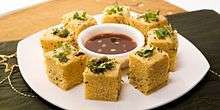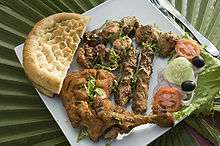Dal
 Lentils are a staple ingredient in cuisines from the Indian subcontinent. Clockwise from upper right: split red lentils, common green whole lentils, and Le Puy lentils. Whole lentils have their outer coats visible. | |
| Alternative names | Daal, dail, dhal, dahl |
|---|---|
| Course | Lunch |
| Region or state | Indian subcontinent |
| Main ingredients | Lentils, peas or beans |
Dal (also spelled daal, dail, dhal, dahl; pronunciation: [d̪aːl]) is a term used in the Indian subcontinent for dried, split pulses (legumes) (that is, lentils, peas, and beans). The term is also used for various soups prepared from these pulses. These pulses are among the most important staple foods in South Asian countries, and form an important part of Indian, Nepalese, Pakistani, Sri Lankan, Afghani, and Bangladeshi cuisines.[1]
Use
The outer hull is usually stripped off; dal that has not been hulled (whole) is described as chilka (skin), e.g. chilka urad dal, mung dal chilka in Hindi/Urdu.[2][3] The term dal is often contrasted with the term gram, used in the Indian subcontinent for pulses that are whole rather than split.[1]
Dals are frequently eaten with flatbreads such as rotis or chapatis, or with rice, a combination referred to as dal bhat. Dals are high in protein relative to other plants.
Etymology
The word dāl derives from the Sanskrit verbal root dal- "to split".[4]
Use by region
Dal preparations are eaten with rice (in eastern India), as well as rotis, chapati and naan (in western India) on the Indian subcontinent. The manner in which it is cooked and presented varies by region. In South India, dal is primarily used to make the dish called sambar. It is also used to make pappu that is mixed with charu and rice.
Nutrition
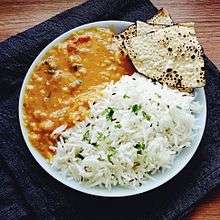
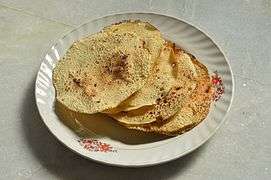
In a 100 gram amount, cooked (boiled) dal contains 9% protein, 70% water, 20% carbohydrates (includes 8% fiber), and 1% fat.[5] Cooked dal (per 100 g) also supplies a rich content (20% or more of the Daily Value, DV) of the B vitamin, folate (45% DV) and manganese (25% DV), with moderate amounts of thiamine (11% DV) and several dietary minerals, such as iron (19% DV) and phosphorus (18% DV).[5]
| Food | Carbs (non-Fiber) | Fiber | Protein | Fat |
|---|---|---|---|---|
| Wheat | 100 | 20.6 | 21.3 | 2.5 |
| Rice | 100 | 1.6 | 9 | 0.8 |
| Soybean | 100 | 44.2 | 174 | 95 |
| Pigeon Pea | 100 | 31 | 45.4 | 3 |
| Milk | 100 | 0 | 61 | 61.8 |
| Guava | 100 | 60 | 28.6 | 11.2 |
| Carrot | 100 | 41.1 | 14.7 | 3.6 |
| Spinach | 100 | 157 | 207 | 28 |
| Potato | 100 | 14.4 | 13 | 0.6 |
| Sweet Potato | 100 | 17.7 | 9.4 | 0.5 |
| Eggplant | 100 | 148 | 43.4 | 8.6 |
| Apple | 100 | 21 | 2.2 | 1.4 |
| Orange | 100 | 25.6 | 1.0 | 1.2 |
Note: Carbohydrates do not include fiber. Source:https://ndb.nal.usda.gov/
| Item | Water | Protein |
|---|---|---|
| Cooked rice[6] | 68.4 | 2.7 |
| Cooked dal[7] | 68.5 | 6.8 |
| Roti[8] | 33.5 | 11.5 |
| Cooked soybean[9] | 62.5 | 16.6 |
| Boiled egg[10] | 74.6 | 12.6 |
| Cooked chicken[11] | 64.3 | 25.3 |
| Vitamins | Minerals | |||||||||||||||||||||||
|---|---|---|---|---|---|---|---|---|---|---|---|---|---|---|---|---|---|---|---|---|---|---|---|---|
| Food | Protein | A | B1 | B2 | B3 | B5 | B6 | B9 | B12 | Ch. | C | D | E | K | Ca | Fe | Mg | P | K | Na | Zn | Cu | Mn | Se |
| cooking Reduction % | 10 | 30 | 20 | 25 | 25 | 35 | 0 | 0 | 30 | 10 | 15 | 20 | 10 | 20 | 5 | 10 | 25 | |||||||
| Rice | 14 | 0 | 12 | 3 | 11 | 20 | 5 | 2 | 0 | 0 | 0 | 0 | 0 | 0 | 1 | 9 | 6 | 7 | 2 | 0 | 8 | 9 | 49 | 22 |
| Wheat | 27 | 0 | 28 | 7 | 34 | 19 | 21 | 11 | 0 | 0 | 0 | 0 | 0 | 0 | 3 | 20 | 36 | 51 | 12 | 0 | 28 | 28 | 151 | 128 |
| Soybean | 73 | 0 | 58 | 51 | 8 | 8 | 19 | 94 | 0 | 24 | 10 | 0 | 4 | 59 | 28 | 87 | 70 | 70 | 51 | 0 | 33 | 83 | 126 | 25 |
| Toor Dal | 43 | 1 | 43 | 11 | 15 | 13 | 13 | 114 | 0 | 0 | 0 | 0 | 0 | 0 | 13 | 29 | 46 | 37 | 40 | 1 | 18 | 53 | 90 | 12 |
| Urad Dal | 45 | 0 | 24 | 21 | 10 | 0 | 22 | 54 | 0 | 0 | 0 | 0 | 0 | 0 | 14 | 58 | 75 | 54 | 21 | 3 | 35 | 0 | 0 | 0 |
| Mung Dal | 43 | 0 | 54 | 19 | 15 | 38 | 29 | 156 | 0 | 0 | 6 | 0 | 3 | 9 | 13 | 52 | 53 | 52 | 27 | 0 | 28 | 0 | 49 | 0 |
| Chana Dal[12] | 25 | 1 | 32 | 12 | 8 | 16 | 27 | 139 | 0 | 17 | 7 | 0 | 0 | 0 | 11 | 35 | 29 | 37 | 25 | 24 | 23 | 42 | 110 | 12 |
Ch. = Choline; Ca = Calcium; Fe = Iron; Mg = Magnesium; P = Phosphorus; K = Potassium; Na = Sodium; Zn = Zinc; Cu = Copper; Mn = Manganese; Se = Selenium; %DV = %Daily value i.e. % of DRI ( Dietary reference intake ) Note : All nutrient values including protein are in %DV per 100 grams of the food item. Significant values are highlighted in light gray color and bold letters.[5][13] Cooking reduction = % Maximum typical reduction in nutrients due to boiling without draining for ovo-lacto-vegetables group[14][15]
Common ingredients
.jpg)
- Pigeon pea, i.e., yellow pigeon peas, is available either plain or oily. It is called thuvaram paruppu in Tamil Nadu, thuvara parippu in Kerala and is the main ingredient for the dish sambar. In Karnataka it is called togari bele and is an important ingredient in bisi bele bath. It is called kandi pappu in Telugu and is used in the preparation of a staple dish pappu charu. It is also known as Arhar dal in northern India.
- Chana dal is produced by removing the outer layer of black chickpeas and then splitting the kernel. Although machines can do this, it can be done at home by soaking the whole chickpeas and removing the loose skins by rubbing. In Karnataka it is called kadle bele. Other varieties of chickpea may be used, e.g., kabuli dal.
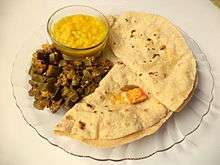
- Yellow split peas, are very prevalent in the Indian communities of Guyana, Fiji, Suriname, South Africa, Mauritius, Trinidad and Tobago, and are popular amongst Indians in the United States as well as India. There, it is referred to generically as dal and is the most popular dal. It is prepared similarly to dals found in India, but may be used in recipes.
- Split mung beans (mung dal) is by far the most popular in Bangladesh. It is used in parts of South India, such as in the Tamil dish ven pongal. Roasted and lightly salted or spiced mung bean is a popular snack in most parts of India.
- Urad dal, sometimes referred to as "black gram", is a primary ingredient of the south Indian dishes idli and dosa. It is one of the main ingredients of East Indian (oriya and Bengali or Assamese) bori, sun-dried dumplings. The Punjabi version is dal makhani. In Karnataka, it is called uddina bele. It is rich in protein.
- Masoor dal: split red lentils. In Karnataka, it is called kempu (red) togari bele.
- Rajma dal: split kidney beans.
- Mussyang is from dals of various colours found in various hilly regions of Nepal.
- Panchratna dal (Hindi/Urdu) ("five jewels") is a mixture of five varieties of dal, which produces a dish with unique flavour.
- Pulses may be split but not hulled; they are distinguished from hulled dals by adding the word chilka (skin).
Split and whole pulses
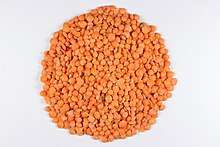
Although dal generally refers to split pulses, whole pulses can be referred to as sabit dhal and split pulses as dhuli dhal.[16] The hulling of a pulse is intended to improve digestibility and palatability, but, as milling of whole grains into refined grains, affects the nutrition provided by the dish, reducing dietary fibre content.[17] Pulses with their outer hulls intact are also quite popular in the Indian subcontinent as the main cuisine. Over 50 different varieties of pulses are known in the Indian subcontinent.
Preparation
.jpg)
Most dal recipes are quite simple to prepare. The standard preparation begins with boiling a variety of dal (or a mix) in water with some turmeric, salt to taste, and then adding a fried garnish at the end of the cooking process. In some recipes, tomatoes, tamarind, unripe mango, or other ingredients are added while cooking the dal, often to impart a sour flavour.
The fried garnish for dal goes by many names, including chaunk, tadka and tarka. The ingredients in the chaunk for each variety of dal vary by region and individual tastes. The raw spices (more commonly cumin seeds, mustard seeds, asafoetida, and sometimes fenugreek seeds and dried red chili pepper) are first fried for a few seconds in the hot oil on medium/low heat. This is generally followed by ginger, garlic, and onion, which are generally fried for 10 minutes. After the onion turns golden brown, ground spices (turmeric, coriander, red chili powder, garam masala, etc.) are added. The chaunk is then poured over the cooked dal.
See also
- Chaunk/Tarka (in Punjabi and Urdu)
- Dal bati churma
- Dal biji
- Ezogelin soup
- Lentil soup
- Pea soup
- Vada
References
- 1 2 Davidson, Alan; Jaine, Tom (2014-01-01). "Dal". The Oxford Companion to Food. Oxford University Press. ISBN 9780199677337.
- ↑ Yotam Ottolenghi. "Pulse points: Yotam Ottolenghi's dried bean and pea recipes". the Guardian. Retrieved 29 September 2015.
- ↑ "Sample recipe for Chilka Urad dhal, split unhulled urad".
- ↑ John Ayto (2012). The Diner's Dictionary: Word Origins of Food and Drink. Oxford University Press. p. 116. ISBN 978-0-19-964024-9.
- 1 2 3 "Lentils, mature seeds, cooked, boiled, without salt per 100 g". Nutritiondata.com by Conde Nast; from USDA National Nutrient Database, Standard Reference 21. 2014. Retrieved 29 September 2015.
- ↑ "Nutrition Facts". self.com. Retrieved 29 September 2015.
- ↑ "Lentils, mature seeds, cooked, boiled, without salt Nutrition Facts & Calories". nutritiondata.self.com.
- ↑ "Food Composition Databases Show Foods -- Bread, chapati or roti, plain, commercially prepared". ndb.nal.usda.gov.
- ↑ "Nutrition Facts". self.com. Retrieved 29 September 2015.
- ↑ "Nutrition Facts". self.com. Retrieved 29 September 2015.
- ↑ "Nutrition Facts". self.com. Retrieved 29 September 2015.
- ↑ "Nutrition Facts". self.com. Retrieved 29 September 2015.
- ↑ "Show Nutrients List". usda.gov. Retrieved 29 September 2015.
- ↑ "USDA Table of Nutrient Retention Factors, Release 6" (PDF). USDA. USDA. Dec 2007.
- ↑ "Nutritional Effects of Food Processing". self.com. Retrieved 29 September 2015.
- ↑ Mehta, Nita (2006). Dal & Roti. SNAB. p12. ISBN 978-81-86004-06-7.
- ↑ Wang, N.; Hatcher, D.W.; Toews, R.; Gawalko, E.J. "Influence of cooking and dehulling on nutritional composition of several varieties of lentils (Lens culinaris)". LWT - Food Science and Technology. 42 (4): 842–848. doi:10.1016/j.lwt.2008.10.007.
Further reading
- Salma Husain; Vijay Thukral (2018). Pull of Pulses: Full of Beans. Niyogi. ISBN 978-93-86906-19-9.
External links
![]()
